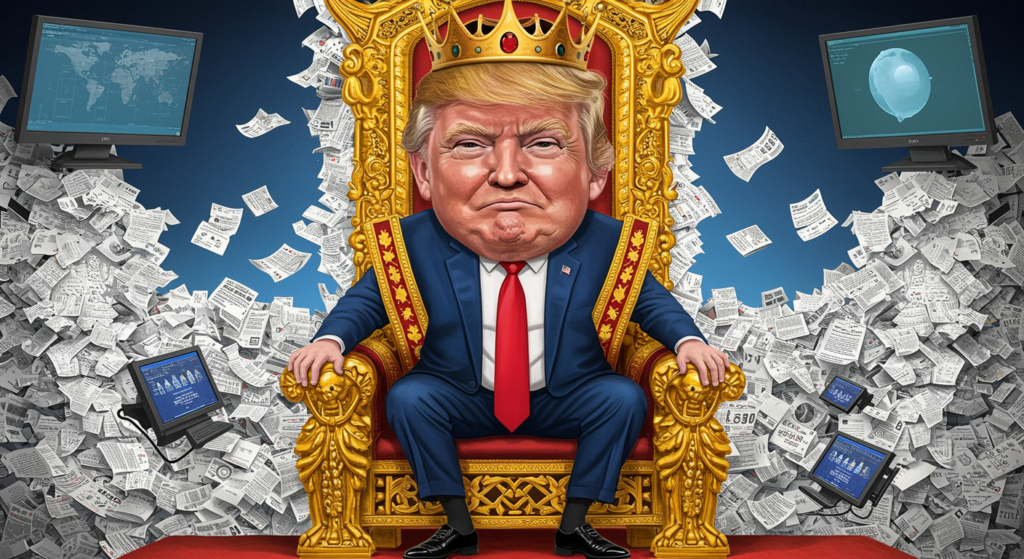
AI Slop: Trump’s Reign as Emperor of Low-Quality AI Content
The AI Content Tsunami
Have you ever scrolled through your feed and stumbled upon a story that feels too wild to be true? That’s often the hallmark of AI slop, a term describing the flood of low-quality, machine-generated content overwhelming our digital world. In recent years, AI slop has surged in political circles, with Donald Trump emerging as a central figure in its proliferation, turning everyday platforms into battlegrounds of misinformation.
This wave isn’t just about quirky memes or harmless fluff; it’s reshaping how we engage with news. AI slop leverages tools like generative AI to crank out sensationalist stories and visuals at lightning speed, often targeting polarizing topics for maximum impact. As Trump’s influence grows, so does the volume of this content, making it harder to separate fact from fiction in our daily feeds.
Understanding AI Slop
At its core, AI slop is about cutting corners in content creation. It’s low-effort material pumped out by algorithms, prioritizing viral potential over accuracy or depth. This phenomenon has exploded with the rise of AI tools, flooding spaces like social media with stories that hook users but deliver little value.
The Mechanics of This Low-Quality AI Phenomenon
AI slop thrives on automation. Generative AI models scrape data from the web, remix it into new forms, and spit out content that’s designed to grab attention. For instance, tools can generate scripts for videos in minutes, complete with fabricated narratives about public figures.
- These systems use vast datasets to mimic human writing, but the results often feel generic and error-prone.
- They target hot-button issues, like political scandals, to drive engagement and ad revenue.
- Operators behind this content, from anonymous creators to small operations, focus on quantity over quality, turning AI slop into a quick-profit machine.
Imagine a world where every trending topic spawns dozens of identical articles— that’s the reality AI slop is building. It’s not just about the tech; it’s about how easily it exploits our thirst for drama.
Trump’s Role in the AI Slop Boom
Donald Trump’s political comeback has supercharged the AI slop economy, with his name attached to countless fabricated tales. Channels on YouTube and TikTok churn out videos featuring made-up scenarios involving Trump allies like Barron Trump or Karoline Leavitt, from fictional diner debates to courtroom victories that never happened.
Why Trump Fuels the AI Slop Machine
Trump’s polarizing style makes him perfect for AI slop creators. His stories generate intense reactions, turning every video into a shareable goldmine. Supporters gobble up content that paints him as a hero, while critics use it to fuel outrage, creating a cycle that keeps the algorithm happy.
- This content often uses AI-generated narration and visuals to look polished, even when it’s completely invented.
- Fans remix and share these pieces, amplifying their reach and turning AI slop into a community-driven phenomenon.
- It’s a reminder that in the age of AI slop, engagement often trumps truth—what starts as a simple video can spiral into widespread belief.
Think about how a single fabricated Trump endorsement video can rack up millions of views. It’s not just entertainment; it’s a strategy that banks on his dedicated base.
The Wider Impact of AI Slop on Society
Beyond the buzz, AI slop is eroding trust in media. We’re seeing AI-generated images and videos that twist real events, like fake endorsements from celebrities or staged protests, muddying the waters of public discourse.
Experts warn that this isn’t harmless fun—it’s fueling misinformation that affects elections and social cohesion. For example, altered photos of minority voters have sparked real-world confusion and division.
“The rise in AI-generated content across political social media concerns experts who say it can be used to push more insidious and believable disinformation.” — Spectrum News
Inside the AI Slop Business Model
What drives this content flood? It’s the promise of easy money. Workers in low-income areas use AI to produce content en masse, uploading to platforms where ads generate revenue. YouTube, for instance, struggles to filter it all out, allowing much of it to slip through.
How AI Slop Factories Operate
These operations are surprisingly straightforward. They start by monitoring trends, then automate everything from writing to video editing.
- Scraping tools pull in hot topics, like Trump-related news, to inspire content.
- AI handles the heavy lifting, creating scripts and visuals in bulk.
- To avoid detection, they use multiple accounts, flooding feeds before platforms can react.
It’s a high-volume game that raises questions: How do we balance innovation with integrity in an era dominated by AI slop?
SEO Challenges in a World of AI Slop
AI slop isn’t just about social media—it’s infiltrating SEO strategies. Tools that generate articles quickly can boost rankings temporarily, but they often lead to repetitive, unhelpful content that search engines penalize.
Google and other engines are shifting toward rewarding original, human-touch content. Yet, the temptation to use AI slop for fast SEO gains persists, especially in competitive niches like politics.
| Factor | Human-Written Content | AI Slop |
|---|---|---|
| Originality | High | Low |
| Fact-Checking | Usually present | Often absent |
| SEO Ranking | Long-term advantage | Short-term spikes |
| Reader Trust | Strengthens over time | Erodes with exposure |
Why AI Slop Flourishes in Trump’s World
Several elements make Trump-era politics a breeding ground for AI slop. His ability to spark debates ensures every piece of content gets shared widely, from exaggerated triumphs to invented scandals.
- High Engagement: Trump stories draw passionate responses, feeding algorithms that prioritize clicks over facts.
- Tribal Identity: Followers crave narratives that reinforce their views, making AI slop a go-to for validation.
- Fragmented Trust: In a divided media landscape, people turn to echo chambers, where AI slop slips in unnoticed.
- Platform Algorithms: These systems amplify sensational content, inadvertently boosting AI slop’s reach.
Consequences for Our Conversations
The fallout is real: AI slop desensitizes us to misinformation, making it tougher to have meaningful debates. What happens when every headline feels suspect? We end up more divided, with facts taking a back seat.
Fighting Back Against AI Slop
The good news? We can push back. Platforms are stepping up with tools to detect and label synthetic content, but users play a key role too. Start by questioning what you see—does that Trump video ring true, or is it classic AI slop?
- Report content that looks fake to help moderators catch it faster.
- Push for better AI detection on your favorite sites.
- Build habits like fact-checking sources before sharing—it’s a simple way to stay ahead of the curve.
If you’re a content creator, focus on originality to stand out from the AI slop crowd. What steps can you take today to make your online experience more reliable?
Wrapping Up: Staying Smart in the AI Age
AI slop, especially tied to figures like Trump, highlights the double-edged sword of modern tech. It’s empowered creators but also unleashed a wave of misleading narratives that threaten our discourse. By staying vigilant, verifying information, and demanding better from platforms, we can navigate this landscape without losing our way.
So, what’s your take on AI slop? Have you spotted any in your feeds lately? Share your thoughts in the comments, spread this article if it resonated, or check out our other posts on digital trends for more insights.
References
- Mother Jones. “AI Slop Farms and Trump.” Link
- KATV. “AI-Generated Images Falsely Depict Trump’s Support.” Link
- Spectrum News. “Trump’s Fake Taylor Swift Endorsement and AI Images.” Link
- Ry Rob. “AI Article Writer Guide.” Link
- YouTube Video. “Related AI Content Discussion.” Link
- YouTube Video. “Another AI Slop Example.” Link
- Holtz Communications. “FIR Cuts from Episode 408.” Link
AI slop, Donald Trump, low-quality AI content, political misinformation, generative AI, AI-generated content, Trump AI slop, digital propaganda, online engagement, misinformation impact







